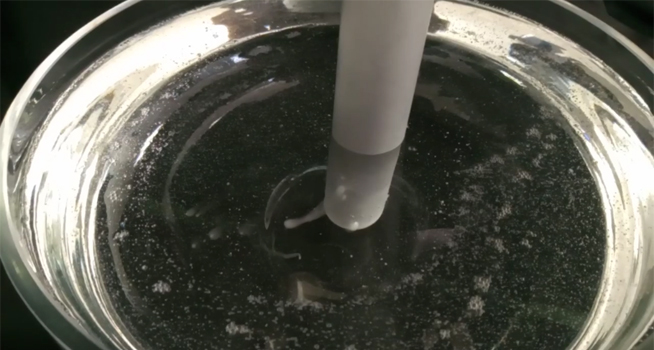Sialon Ceramics Ltd and Aktive Arc Sarl announced the development of a physical model of ultrasonic degassing of molten glass using glycerine. The model demonstrates proof of concept and provides a test bed for further study.
Glycerine has a similar viscosity to molten glass. By carrying out the experiments at room temperature, it was possible to easily monitor the ultrasonic cavitation effects and bubble removal process. Two experimental setups were used to observe and record the degassing process visually. Physically modelling ultrasonic degassing of glass using glycerine means that further process optimisation can be carried out readily.
Ultrasonic Cavitation involves applying ultrasonic waves to liquids resulting in the production, growth, pulsation and collapse or coalescing of micro-bubbles. Cavitation is initiated once a threshold energy level is reached, which is approximately 0.15 MPa for glycerine. As a result, many thousands of bubbles are formed. These expand and rapidly collapse, creating high-velocity shock waves and high pressures of several GPa. Localised high temperatures also occur.
Gas bubbles form on the cavitation nuclei and grow by diffusion from the glycerine into the bubble. If the liquid already contains bubbles, then these undergo diffusion growth. Individual bubbles coalesce due to attractive forces between them (Bjerknes and Bernoulli forces). As they grow, their buoyancies increase, and they float to the surface and release the gas to the atmosphere.
Nico van Dongen, Director of Sialon Ceramics, described the experimental setup. “We developed two setups. The first used a 4.5-litre bowl of glycerine in which we placed a ceramic sonotrode. In the second, we used a glycerine filled quartz glass cell that we subjected to external ultrasonic energy.”
The sonotrode and a new series of NIMA generators are part of an ultrasonic system that has been specially developed to eliminate standing waves at 20 kHz. This new system avoids any potential danger of sonotrode cracking, a problem previously encountered.
The results of the experiment were stunning. In both setups, bubble growth and bubble transport by acoustic streaming were clearly visible. Furthermore, the intensity of acoustic streaming can be regulated by the ultrasonic power output. With sufficient energy thick bubble clouds will be formed and eventually these reached the surface of the liquid and dispersed.
Mario Plasencia, Director of Aktive Arc Ultrasonics, explained, “In the first setup, cavitation streaming could be achieved for many centimetres from the sonotrode surface. In the second setup, streamers formed throughout the liquid. Because of the shape of the container and the effects of standing waves, nodal and anti-nodal zones of high and low energy could be seen. In both zones, we could see bubbles move towards each other and merge.”
Sialon Ceramics has posted a video of the degassing process on YouTube.
At the start of the experiment, both glycerine samples contained many tiny bubbles making them semi-opaque. Over time, the bubbles were removed, and the glycerine samples were clarified. It took about ten minutes to clear 4.5 litres of glycerine.
Ultrasonic degassing of molten glass has many benefits compared to conventional degassing methods. For example, it is faster, uses considerably less energy, and uses no toxic additives. In addition, physically modelling the process using glycerine provides an ideal way to study further and optimise the process.
Mario Plasencia, Director of Aktive Arc Ultrasonics, added, “This is great news for the environment. Ultrasonic degassing of molten glass can save huge amounts of energy and potentially reduce the carbon footprint of glass manufacture substantially. In addition, we now can optimise this process further.”




